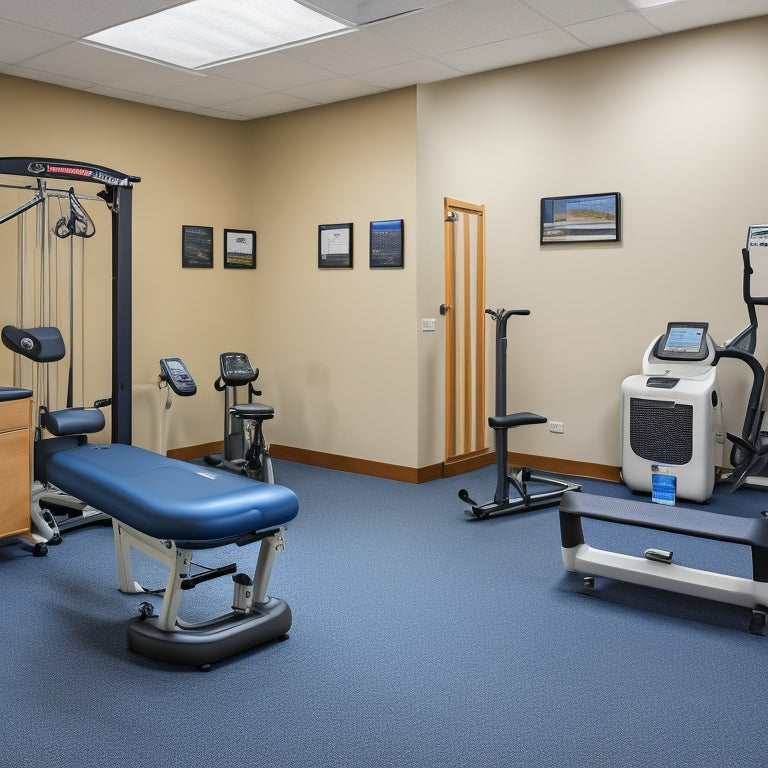
Maximize Efficiency: Organize Physical Therapy Equipment Strategically
Share
To maximize efficiency in physical therapy equipment organization, adopt a strategic approach. Start by utilizing clear containers for storage, prioritizing supplies based on frequency of use, and implementing a labeling system to facilitate quick retrieval. Maintain accurate inventory lists through regular audits, and train staff on proper organization and inventory management techniques to guarantee sustainability. By streamlining storage and optimizing supply access, physical therapists can reduce treatment delays and improve overall patient care. By organizing equipment strategically, clinics can access even more benefits, such as enhanced productivity and reduced costs.
Key Takeaways
• Implement clear containers for storage to enhance visibility, accessibility, and organization of physical therapy equipment.
• Prioritize equipment based on frequency of use, grouping similar items together to optimize storage space and reduce treatment delays.
• Establish a well-designed labeling system with clear and descriptive labels to swiftly locate equipment and supplies.
• Conduct regular inventory audits to maintain accurate stock levels, track expiration dates, and ensure patient safety.
• Provide staff training on proper organization techniques, inventory management practices, and guidelines for maintaining organized storage areas to ensure sustainable efficiency.
Streamline Storage With Clear Containers
By shifting from opaque containers to clear bins, physical therapy clinics can greatly enhance the visibility and accessibility of their stored supplies, thereby streamlining storage and retrieval processes. This simple yet effective strategy enables clinicians to quickly identify contents, reducing search time and promoting a clutter-free environment.
Utilize transparent bins to optimize visibility, making it easier to locate specific items and preventing unnecessary digging through stacks of supplies. Emptying out cardboard boxes and switching to clear containers also aids in efficient organization, improving the overall aesthetics of the storage room.
Prioritize Supplies for Easy Access
Categorizing physical therapy supplies based on their frequency of use allows clinicians to prioritize essential items, guaranteeing easy access and streamlining treatment workflows.
This equipment categorization strategy allows for accessible storage, where frequently used items are stored in convenient locations, reducing treatment delays.
By grouping similar items together based on usage frequency, clinicians can optimize storage space and facilitate organized retrieval.
This approach guarantees that critical supplies are readily available when needed, enabling clinicians to focus on providing high-quality patient care.
Implement a Labeling System
A well-designed labeling system enables physical therapists to swiftly locate specific supplies, reducing treatment delays and enhancing overall clinic efficiency.
By implementing a labeling system, clinics can improve visibility and enhance organization of their physical therapy equipment. Clear and descriptive labels on containers and bins enable staff to quickly identify contents, reducing search time and increasing productivity.
Additionally, color-coding labels can be used to categorize supplies, further streamlining retrieval. This system also promotes consistency in maintaining organization, ensuring that supplies are returned to their designated places after use.
Maintain Accurate Inventory Lists
Effective inventory management relies on maintaining accurate lists that reflect the current stock levels of physical therapy equipment and supplies, enabling clinicians to track usage, identify shortages, and make informed decisions about replenishment. This process involves conducting regular audits to ensure that inventory lists are up-to-date and accurate. Additionally, tracking expiration dates of medical supplies is vital to prevent stockouts and ensure patient safety.
| Inventory Management Tasks | Frequency | Responsibility |
|---|---|---|
| Conducting regular audits | Quarterly | Supply Manager |
| Tracking expiration dates | Monthly | Clinical Staff |
| Updating inventory lists | Weekly | Administrative Assistant |
Train Staff for Sustainable Organization
To guarantee that the organized storage areas and accurate inventory lists are maintained over time, it is important to educate and train physical therapy staff on proper organization techniques and inventory management practices. This staff training is essential for sustainable organization, as it ensures that the entire team is on the same page.
Provide guidelines for maintaining organized storage areas, and offer refresher courses on inventory management to reinforce best practices. Educate staff on the importance of organization and its impact on efficiency, productivity, and patient care.
Frequently Asked Questions
How Do I Handle Equipment With Unique Storage Requirements?
When handling equipment with unique storage requirements, utilize specialized containers designed for specific items, and consider adaptive shelving solutions that accommodate varying sizes and shapes, ensuring ideal storage and easy accessibility.
Can I Customize Storage Solutions for Specific Therapy Areas?
"A million possibilities await! Customizing storage solutions for specific therapy areas is a breeze with modular systems and adaptive layouts, allowing for tailored configurations that optimize space, streamline workflows, and revolutionize therapy sessions."
What Are Some Common Mistakes to Avoid When Organizing Equipment?
When organizing equipment, common mistakes to avoid include failing to purge unnecessary items, leading to clutter consequences and space wastage, as well as inadequate labeling and categorization, resulting in inefficient storage and retrieval systems.
How Often Should I Clean and Disinfect Stored Equipment?
'Diligently design daily schedules to dedicate time for disinfection, ensuring equipment cleanliness. Establish thorough cleaning protocols to guarantee sanitized storage, preventing cross-contamination and promoting a pristine physical therapy environment.'
Are There Any Specific Regulations for Storing Sensitive Patient Data?
When storing sensitive patient data, guarantee compliance with HIPAA regulations by implementing robust data encryption methods, such as AES encryption, and adhering to secure storage protocols to protect patient confidentiality and maintain data integrity.
Related Posts
-

Storage Bins for Shelves to Keep Clutter at Bay
You're looking for a way to keep your shelves organized and clutter-free, and storage bins are the perfect solution t...
-

10 Essential Steps for Small Parts Bin Storage
To optimize your small parts bin storage, start by defining your storage needs and goals, considering factors like av...
-

Heavy-Duty Commercial Rolling Shelving Racks
You need heavy-duty commercial rolling shelving racks that optimize your storage capacity, streamline operations, and...


